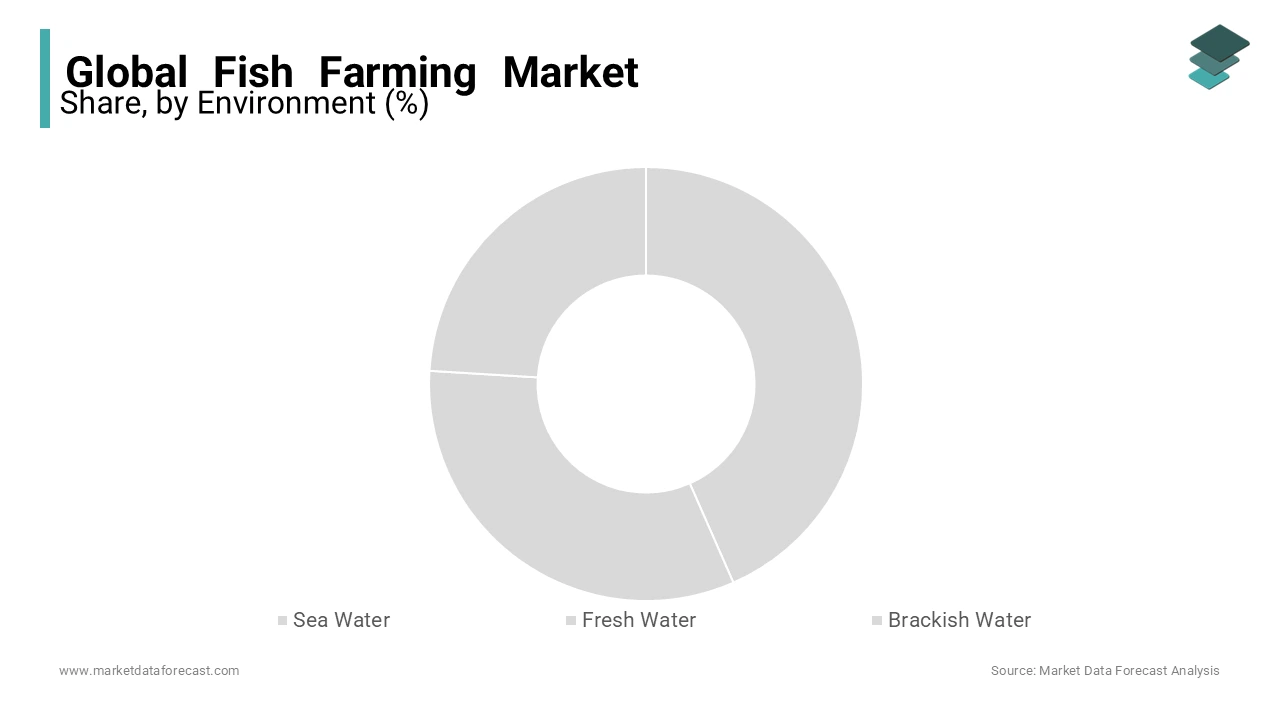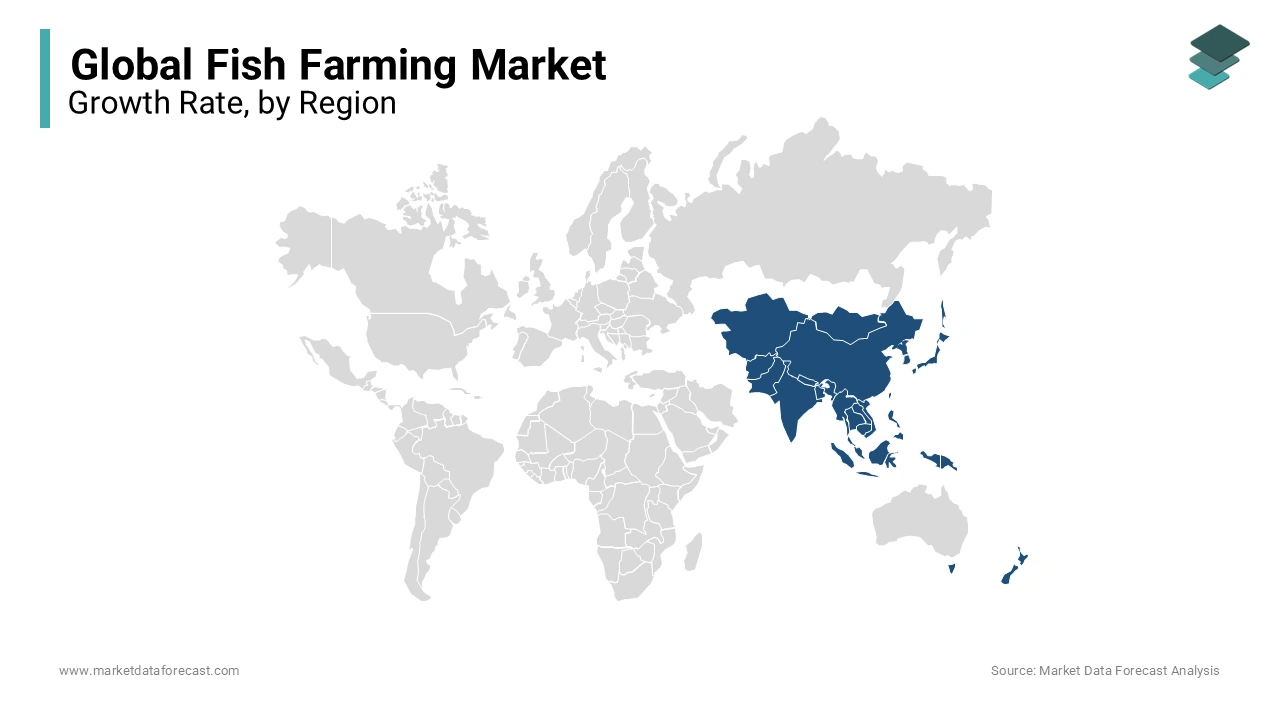Global Fish Farming Market Size, Share, Trends & Growth Forecast Report - Segmented By Environment (Marine Water, Freshwater And Brackish Water), Type (Fin Fish And Others), And Region(North America, Europe, Asia-Pacific, Latin America, Middle East And Africa) - Global Industry Analysis, Size, Share, Growth, Trends And Forecast 2025 To 2033
Global Fish Farming Market Size
The size of the global fish farming market is expected to be worth USD 319.35 billion in 2024 and is anticipated to be worth USD 530.44 billion by 2033 from USD 337.87 billion In 2025, growing at a CAGR of 5.80% during the forecast period.

Fish farming is a type of farming, where fish are raised and sold as food in an enclosed space. More than half of the fish consumed worldwide is now raised in artificial environments. Fish farming is a term used to define the activities of fish farms. This aquaculture procedure includes interventions in the breeding process to improve production, such as feeding, regular breeding and protection from predators. Fish farming currently includes 580 species that are farmed worldwide, representing great genetic diversity within and between species. Fish farming involves the farming of fish on a commercial scale in ponds, tanks, or other enclosures. Fish farming was the solution to the problem of overfishing. Fish farming is practiced by some farmers in developing countries and multinational corporations that may own their growing livestock. It is a good source of essential fatty acids, proteins, minerals, vitamins and micronutrients. The global fish farming market is determined to experience significant growth during the forecast period as consumer awareness of balanced nutrient intake increases.
MARKET DRIVERS
The growth of the fish farming market can be attributed to changes in the food consumption patterns of people around the world.
Currently, fish farming is absolutely necessary to satisfy the supply and demand for food. With the expansion of the retail market and easy access to products through various sales channels, consumers can buy packaged fish conveniently, boosting sales. Fish farming activities are also used by industry to preserve endangered species. The increasing popularity of high protein diets is expected to pave the way for the global fish farming market. The high consumption of fish worldwide has been a key factor in the growth of this market. The world market for fish farming registers constant changes in its dynamics. Market trends are affecting overall performance. The governments of various countries are promoting freshwater aquaculture with us and are having a positive impact on this market in response to the growing demand for food. In many places, fish is an important part of the consumer's daily diet. In other regions, knowledge of the health benefits of fish has significantly improved this market. The increase in the consumption of omega 3 as a dietary supplement in the coming years will positively reflect the growth of this market, which will have a great impact on aquaculture. Fish is included in the category of products that consumers usually buy. Furthermore, continuous technological advances in fishing equipment and efforts to revitalize aquaculture are complementing the global fish market.
As a cultural tradition for many people, increased fish consumption and a greater awareness of the health benefits of fish are expected to drive the growth of the global fish farming market. Also, the increasing application of fish oil in various industries, such as dietary supplements, food industry, healthcare and pharmaceuticals, is accelerating market growth and as the population continues to grow, fishing will always play an important role in the human diet. Organic fish products that have multiple health benefits and do not use antibiotics or additional nutrients. Fish is one of the most profitable and reliable meat sources for animal protein. Key factors driving the growth of the global market include continued technological advancements in the aquaculture sector, the increasing demand for protein in fisheries and livestock, and the growth of fish production to meet the food supply. It has been observed that the current population is growing rapidly due to rapid urbanization compared to the last 20-30 years. People living in socioeconomic families or poor people do not have access to the nutritional diet they need for their well-being. Fish also offers a number of health benefits, such as reducing the risk of heart disease, reducing depression, improving vision, and lowering cholesterol. Therefore, the growth of fish production to cover the food supply is driving the growth of the market.
Most of the food consumed uses low-cost cereals or basic ingredients because the budget to buy fruits or vegetables is limited. Therefore, fish produced through aquaculture is relatively inexpensive and rich in protein along with other important vitamins and minerals. The rising need for fish production has put pressure on the fishing industry and created the need to use new innovative technologies in aquaculture. These techniques provide the opportunity to understand and study the natural environment of fish. This understanding of the fish environment can help provide a more natural experience for fish in production. Therefore, advancements in fish farming technology will drive market growth.
MARKET RESTRAINTS
The increasing adoption of vegan diets and strict laws prohibiting cruelty to animals are a major constraint on the global Fish Farming market.
Rising temperatures and rising water pollution levels could hamper this market's growth trajectory in the coming years. Increased water pollution and changes in weather conditions hamper the growth of the Fish Farming Market market. Furthermore, aquaculture production is susceptible to the adverse effects of diseases such as the carp herpes virus, a viral disease that interferes with fish production. Disease outbreaks in recent years have affected Atlantic salmon farmed in Chile and several countries in South America, Asia and Africa, resulting in a partial or total loss of production, slowing the growth of the market.
REPORT COVERAGE
|
REPORT METRIC |
DETAILS |
|
Market Size Available |
2024 to 2033 |
|
Base Year |
2024 |
|
Forecast Period |
2025 to 2033 |
|
CAGR |
5.80% |
|
Segments Covered |
By Environment, Type, & Region |
|
Various Analyses Covered |
Global, Regional & Country Level Analysis, Segment-Level Analysis, DROC; PESTLE Analysis. Porter’s Five Forces Analysis, Competitive Landscape; Analyst Overview of Investment Opportunities |
|
Regions Covered |
North America, Europe, APAC, Latin America, Middle East & Africa |
|
Market Leaders Profiled |
Fish Farming Technologies Asia Limited, Alpha Group Ltd, Cooke Aquaculture Inc, Cermaq Group AS, Marine Harvest Group, Tassal Group Limited, Lerøy Seafood Group ASA, P/F Bakkafrost, Nippon Suisan Kaisha Ltd, and Thai Union Group PCL |
SEGMENTAL ANALYSIS
Global Fish Farming Market Analysis By Environment

Of these, the freshwater sector is supposed to lead the market during the outlook period. This is because the governments of several countries continue to promote the use of freshwater fish farming.
Global Fish Farming Market Analysis By Type
Of these, the fin portion is supposed to witness a higher CAGR during the conjecture period. This is due to the high demand for mollusks around the world as a high-quality pearl. They are very nutritious, so their demand in the market is even higher.
REGIONAL ANALYSIS

The Asia Pacific region is foreseen to lead the fish farming market during the conjecture period. Fish is one of the main sources of protein and aquaculture is one of the main occupations of most of the population of the region, which drives the growth of the market in the region. High population growth and broad fish consumption base are key factors in the growth of the Asia Pacific fish farming market. The emergence of efficient fish farming technologies, such as intensive closed systems, has helped to increase the profitability of fish farms and has also had a positive impact on the local market. This growth is mainly due to a significant increase in fishing activity in Asian countries such as India, Japan, Thailand and China. With this trend intact, this regional market is determined to remain a leader in the global fish farming market in the coming years. In North America, fish farming has stopped expanding in recent years, but in South America it has experienced strong and sustained growth, especially in Brazil and Peru.
KEY PLAYERS IN THE GLOBAL FISH FARMING MARKET
Major Key Players in the global fish farming market are Fish Farming Technologies Asia Limited, Alpha Group Ltd, Cooke Aquaculture Inc, Cermaq Group AS, Marine Harvest Group, Tassal Group Limited, Lerøy Seafood Group ASA, P/F Bakkafrost, Nippon Suisan Kaisha Ltd, and Thai Union Group PCL
DETAILED SEGMENTATION OF THE GLOBAL FISH FARMING MARKET INCLUDED IN THIS REPORT
This research report on the global fish farming market has been segmented and sub-segmented based on environment, type, and region.
By Environment
- Sea Water
- Fresh Water
- Brackish Water
By Type
- Fish Finder
- Others
By Region
- North America
- Europe
- Asia and Pacific
- Middle East and Africa
- Latin America
Frequently Asked Questions
1. What are the key trends driving the fish farming market?
Trends include the adoption of sustainable aquaculture practices, increasing demand for premium and organic seafood products, technological innovations in fish feed and disease management, and the rise of land-based RAS facilities.
2. What are the challenges facing the fish farming industry?
Challenges include disease outbreaks, environmental sustainability concerns, competition for resources such as land and water, regulatory complexities, market volatility, and social acceptance issues related to aquaculture practices.
3. How is technology transforming the fish farming market?
Technology is driving improvements in fish health monitoring, feed efficiency, water quality management, automation of farming operations, genetic selection for desirable traits, and traceability systems to ensure product quality and safety.
Related Reports
Access the study in MULTIPLE FORMATS
Purchase options starting from $ 2500
Didn’t find what you’re looking for?
TALK TO OUR ANALYST TEAM
Need something within your budget?
NO WORRIES! WE GOT YOU COVERED!
Call us on: +1 888 702 9696 (U.S Toll Free)
Write to us: [email protected]